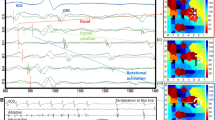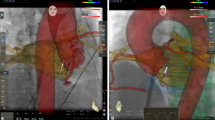Abstract
Atrial fibrillation (AF) is often successfully treated by catheter ablation. Those cases of AF that do not readily succumb to ablation therapy would benefit from improved methods for mapping the complex spatial patterns of tissue activation that typify recalcitrant AF. To this end, the purpose of our study was to investigate the use of numerical deconvolution to improve the spatial resolution of activation maps provided by 2-D arrays of intra-cardiac recording electrodes. We simulated tissue activation patterns and their corresponding electric potential maps using a computational model of cardiac electrophysiology, and sampled the maps over a grid of locations to generate a mapping data set. Following cubic spline interpolation, followed by edge-extension and windowing, we deconvolved the data and compared the results to the model current density fields. We performed a similar analysis on voltage-sensitive dye maps obtained in isolated sheep hearts. For both the synthetic data and the voltage-sensitive dye maps, we found that deconvolution led to visually improved map resolution for arrays of 10 × 10 up to 30 × 30 electrodes placed within a few mm of the atrial surface when the activation patterns included 3–4 features that spanned the recording area. Root mean square error was also reduced by deconvolution. Deconvolution of arrays of intracardiac potentials, preceded by appropriate interpolation and edge processing, leads to potentially useful improvements in map resolution that may allow more effective assessment of the spatiotemporal dynamics of tissue excitation during AF.








Similar content being viewed by others
References
Calkins H, Reynolds MR, Spector P, Sondhi M, Xu Y, Martin A, Williams CJ, Sledge I. Treatment of atrial fibrillation with antiarrhythmic drugs or radiofrequency ablation: two systematic literature reviews and meta-analyses. Circ Arrhythm Electrophysiol. 2009;2:349–61.
Habel N, Znojkiewicz P, Thompson N, Muller JG, Mason B, Calame J, Calame S, Sharma S, Mirchandani G, Janks D, Bates J, Noori A, Karnbach A, Lustgarten DL, Sobel BE, Spector P. The temporal variability of dominant frequency and complex fractionated atrial electrograms constrains the validity of sequential mapping in human atrial fibrillation. Heart Rhythm. 2010;7:586–93.
Stinnett-Donnelly JM, Thompson N, Habel N, Petrov-Kondratov V, Correa de Sa DD, Bates JH, Spector PS. Effects of electrode size and spacing on the resolution of intracardiac electrograms. Coron Artery Dis. 2012;23:126–32.
Bates JH, Spector PS. On the ill-conditioned nature of the intracardiac inverse problem. Conf Proc IEEE Eng Med Biol Soc. 2009;2009:3929–31.
Spector PS, Habel N, Sobel BE, Bates JH. Emergence of complex behavior: an interactive model of cardiac excitation provides a powerful tool for understanding electric propagation. Circ Arrhythm Electrophysiol. 2011;4:586–91.
Chouvarda I, Maglaveras N, de Bakker JM, van Capelle FJ, Pappas C. Deconvolution and wavelet-based methods for membrane current estimation from simulated fractionated electrograms. IEEE Trans Biomed Eng. 2001;48:294–301.
Harris FJ. On the use of windows for harmonic analysis with the discrete Fourier transform. Proc IEEE. 1978;66:51–83.
Smith SW. The scientist and engineer’s guide to digital signal processing. San Diego: Technical; 1997.
McDonnell MJ, Bates RHT. Preprocessing of degraded images to augment existing restoration methods. Comput Graph Image Process. 1975;4:25–39.
Yamazaki M, Avula UM, Bandaru K, Atreya A, Boppana VS, Honjo H, Kodama I, Kamiya K, Kalifa J. Acute regional left atrial ischemia causes acceleration of atrial drivers during atrial fibrillation. Heart Rhythm. 2013;10:901–9.
Brault JW, White OR. The analysis and restoration of astronomical data via the fast Fourier transform. Astron Astrophys. 1971;13:169–89.
Bates JHT, Fright WR, Bates RHT. Wiener filtering and cleaning in a general image processing context. Mon Not R Astron Soc. 1984;211(1):1–14.
Rostock T, Salukhe TV, Steven D, Drewitz I, Hoffmann BA, Bock K, Servatius H, Mullerleile K, Sultan A, Gosau N, Meinertz T, Wegscheider K, Willems S. Long-term single- and multiple-procedure outcome and predictors of success after catheter ablation for persistent atrial fibrillation. Heart Rhythm. 2011;8:1391–7.
Mandapati R, Skanes A, Chen J, Berenfeld O, Jalife J. Stable microreentrant sources as a mechanism of atrial fibrillation in the isolated sheep heart. Circulation. 2000;101:194–9.
Jalife J. Rotors and spiral waves in atrial fibrillation. J Cardiovasc Electrophysiol. 2003;14:776–80.
Allessie MA. The electropathological substrate of longstanding persistent atrial fibrillation in patients with structural heart disease: longitudinal dissociation. Circ Arrhythm Electrophysiol. 2010;3(6):606–15.
Correa de Sa DD, Thompson N, Stinnett-Donnelly J, Znojkiewicz P, Habel N, Muller JG, Bates JH, Buzas JS, Spector PS. Electrogram fractionation: the relationship between spatiotemporal variation of tissue excitation and electrode spatial resolution. Circ Arrhythm Electrophysiol. 2011;4:909–16.
Hofer E, Keplinger F, Thurner T, Wiener T, Sanchez-Quintana D, Climent V, Plank G. A new floating sensor array to detect electric near fields of beating heart preparations. Biosens Bioelectron. 2006;21:2232–9.
van Oosterom A. The inverse problem of bioelectricity: an evaluation. Med Biol Eng Comput. 2012;50:891–902.
Ellis WS, Eisenberg SJ, Auslander DM, Dae MW, Zakhor A, Lesh MD. Deconvolution: a novel signal processing approach for determining activation time from fractionated electrograms and detecting infarcted tissue. Circulation. 1996;94:2633–40.
Acknowledgments
This work was supported by a grant from Medtronic, Inc., Minneapolis, MN, USA.
Conflict of interest
All the authors declared that they have no conflict of interest.
Author information
Authors and Affiliations
Corresponding author
Rights and permissions
About this article
Cite this article
Palmer, K.B., Thompson, N.C., Spector, P.S. et al. Digital resolution enhancement of intracardiac excitation maps during atrial fibrillation. J Clin Monit Comput 29, 279–289 (2015). https://doi.org/10.1007/s10877-014-9597-z
Received:
Accepted:
Published:
Issue Date:
DOI: https://doi.org/10.1007/s10877-014-9597-z




